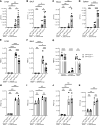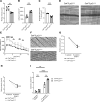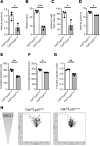Csk-mediated Src family kinase regulation dampens neutrophil infiltration during pulmonary infection
- PMID: 40493407
- PMCID: PMC12288981
- DOI: 10.1172/jci.insight.188323
Csk-mediated Src family kinase regulation dampens neutrophil infiltration during pulmonary infection
Abstract
Neutrophil recruitment is crucial for pathogen elimination. However, precise control of the inflammatory response prevents overshooting reactions. Neutrophil activation initiates signaling, resulting in integrin β2 (Itgb2) activation and neutrophil arrest. Src family kinases are involved in multiple cellular processes and are negatively regulated by the C-terminal Src kinase (Csk). During this study, we investigated the mechanism by which Csk regulates integrin activation and neutrophil recruitment. Here, we demonstrated that Csk deficiency in murine neutrophils resulted in increased neutrophil adhesion to the endothelium along with decreased neutrophil transmigration into inflamed tissues compared with their littermate controls. In bacterial pneumonia, infected Csk-deficient mice showed higher bacterial burdens and decreased neutrophil recruitment, while other immune cell counts and cytokine levels were not significantly different compared to control. Analyses of Csk-deficient neutrophils revealed an increased Itgb2 affinity, leading to reduced migration and intravascular crawling. Mechanistically, elevated cAMP levels increased protein kinase A activity, which subsequently enhanced Csk activation. Csk, in turn, suppressed Src family kinase activation through phosphorylation (Y529). Hence, Csk-mediated regulation of neutrophil infiltration contributes to maintain a balanced immune response during bacterial pneumonia.
Keywords: Immunology; Inflammation; Integrins; Neutrophils.
Figures







Similar articles
-
Neutrophil CRACR2A Promotes Neutrophil Recruitment in Sterile Inflammation and Ischemic Stroke.Circulation. 2025 Mar 11;151(10):696-715. doi: 10.1161/CIRCULATIONAHA.124.070487. Epub 2024 Nov 27. Circulation. 2025. PMID: 39601147
-
Alpha-1 antitrypsin modulates neutrophil phenotype and function: implications for inflammatory regulation.J Leukoc Biol. 2025 Jun 4;117(6):qiaf091. doi: 10.1093/jleuko/qiaf091. J Leukoc Biol. 2025. PMID: 40590483 Free PMC article.
-
γδ T Cells Mediate Protection against Neutrophil-associated Lung Inflammation in Pulmonary Melioidosis.Am J Respir Cell Mol Biol. 2024 Nov;71(5):546-558. doi: 10.1165/rcmb.2024-0072OC. Am J Respir Cell Mol Biol. 2024. PMID: 38935886 Free PMC article.
-
The Effect of Radiation Treatment of Solid Tumors on Neutrophil Infiltration and Function: A Systematic Review.Int J Radiat Oncol Biol Phys. 2024 Nov 1;120(3):845-861. doi: 10.1016/j.ijrobp.2024.07.2141. Epub 2024 Jul 14. Int J Radiat Oncol Biol Phys. 2024. PMID: 39009323
-
Antiretrovirals for reducing the risk of mother-to-child transmission of HIV infection.Cochrane Database Syst Rev. 2011 Jul 6;(7):CD003510. doi: 10.1002/14651858.CD003510.pub3. Cochrane Database Syst Rev. 2011. PMID: 21735394
References
MeSH terms
Substances
LinkOut - more resources
Full Text Sources
Miscellaneous

